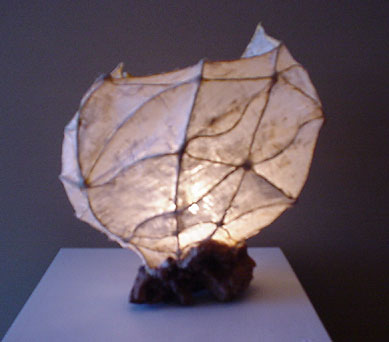|
by: Maddy Cranley

Just when we have all learned to
correctly pronounce Feng Shui, the Chinese art of appropriate placement
of objects in our living spaces, along comes another ancient Oriental
aesthetic philosophy, "wabi-sabi". Seemingly destined to become as
popular as Feng Shui, wabi-sabi addresses our relationship to all things
that surround us, not just to their positioning in our living and
working environments. Plainly stated, the basic tenets of wabi-sabi are
simple is best, less is more. Leonard Koren in his book "Wabi-Sabi: for
Artists, Designers, Poets and Philosophers (Stonebridge Press, 1995)
describes it as a beauty "… of things imperfect, impermanent and
incomplete, modest and humble and of things unconventional."
It is actually a difficult concept to
describe. Once it is defined, thereby giving it a form, it loses the
essence which makes it what it is. Wabi-sabi began in 14th century Japan
as a reaction to the rich materials, brilliant colors and lavish
ornamentation displayed by the Chinese culture. Today the popularity of
wabi-sabi could be viewed as a response to our high tech world in which
exactness and duplication are so prized that designer logos are worn
front and center on clothing to identify it as being a perfect match to
all others produced by that same designer. Something so exact and
mass-produced is definitely not wabi-sabi.
Natural and crafted objects are
wabi-sabi because they so often display an individuality that cannot be
duplicated. A hand knit sweater would definitely qualify as wabi-sabi.
Yes, many knitters may knit the same sweater from the exact same pattern
instructions, even using an identical yarn, but each resulting sweater
will likely have subtle differences. An individual knitter's tension,
which can sometimes vary from day to day, will certainly vary from
knitter to knitter. Slubs and bumps even in the same brand of yarn will
appear in different places in the garment and differences in
needle-holding technique can sometimes be evident in the twist of the
finished knitting. This is wabi-sabi. In contrast, a mass-produced knit
sweater, created with the same computer-controlled machinery will
guarantee that all the sweaters will look exactly alike - definitely not
wabi-sabi.
 Wabi-sabi also prizes the dented and
scratched, the bumpy and irregular, the weathered and worn. Perfection
is sterile. Imperfection is beautiful. So here's a different way to look
at those dropped stitches that were recovered onto the needle, with that
ever so slight a twist of the yarn, or at the variance in a dye lot that
results in a line across your back that only you can see. It is these
imperfections that give the sweater its unique beauty. Wabi-sabi also prizes the dented and
scratched, the bumpy and irregular, the weathered and worn. Perfection
is sterile. Imperfection is beautiful. So here's a different way to look
at those dropped stitches that were recovered onto the needle, with that
ever so slight a twist of the yarn, or at the variance in a dye lot that
results in a line across your back that only you can see. It is these
imperfections that give the sweater its unique beauty.
The concept of wabi-sabi embraces the
passage of time. The slightly felted but dearly loved old woolen sweater
that you cannot part with and the knitted teddy bear, torn and ragged
from a child's love, all embody wabi-sabi. These characteristics suggest
that the object has a history. No brand name or high price tag could
change what these objects mean to the owner. It's value is gauged on a
very personal and private level.
So take pride in your wabi-sabi
knitting. Be proud of that noticeable slub in the yarn, the slightly
stretchy neckline or the twisted picked-up stitch. You have seen a
simple strand of yarn develop into a unique garment, one that stands
alone and unmatched, but best of all prized by you - that's wabi-sabi.
About
the Author:
Maddy Cranley is a professional knitwear designer,
who has created exclusive designs for knitting and craft
magazines, authored and published three books on the
subject of knitting and felting, and produces an
ever-expanding line of maddy laine and maddy baby
handknitting patterns. For additional information, see
http://www.maddycraft.com
|



